- Home
- Robert K. Massie
Nicholas and Alexandra Page 2
Nicholas and Alexandra Read online
Page 2
Beinecke Library, Yale University
The
S
TANDART
Beinecke Library, Yale University
Pierre Gilliard and Alexis
Beinecke Library, Yale University
Nicholas and Alexandra aboard the
S
TANDART
Beinecke Library, Yale University
Picnicking on the coast of Finland
Beinecke Library, Yale University
Derevenko and Alexis
Beinecke Library, Yale University
The Tsar
Beinecke Library, Yale University
The Empress
Beinecke Library, Yale University
Nicholas with his officers
Beinecke Library, Yale University
Nicholas with Alexis
Beinecke Library, Yale University
Alexandra in her mauve boudoir
Beinecke Library, Yale University
Alexandra with Alexis
Beinecke Library, Yalne University
Nagorny and Alexis
Beinecke Library, Yale University
Derevenko and Alexis
Beinecke Library, Yale University
Livadia: Pierre Gilliard, Olga, Tatiana
Beinecke Library, Yale University
At Spala: Alexandra
Beinecke Library, Yale University
After Spala: Alexis
Beinecke Library, Yale University
Gregory Rasputin
Culver
Nicholas and Alexis during the war
Underwood & Underwood
In a hospital: Olga, Tatiana, Alexandra
Beinecke Library, Yale University
The Tsar with Grand Duke Nicholas
Combine
Anastasia
Marie, Tatiana, Olga
Beinecke Library, Yale University
Nicholas, Alexis, Tatiana
Radio Times Hulton
The Empress
Beinecke Library, Yale University
Imprisoned at Tsarskoe Selo
N. Teliatnikow
Cast of Characters
NICHOLAS II, TSAR OF RUSSIA, 1894—1917
Before 1894, the Tsarevich Nicholas
ALEXANDRA FEDOROVNA, EMPRESS OF RUSSIA
Born Princess Alix of Hesse-Darmstadt
ALEXIS, THE TSAREVICH
Fifth child and only son of Nicholas and Alexandra
ALEXANDER III, TSAR OF RUSSIA, 1881—1894
Father of Nicholas II
MARIE FEDOROVNA, DOWAGER EMPRESS
Mother of Nicholas II. Born Princess Dagmar of Denmark
GRAND DUCHESS MARIE PAVLOVNA Wife of Grand Duke Vladimir
GRAND DUCHESS ELIZABETH (Ella)
Sister of Empress Alexandra and wife of Grand Duke Serge
GRAND DUKE NICHOLAS NICOLAIEVICH
Commander-in-Chief of the Russian Army in World War I
GRAND DUKE ALEXANDER MIKHAILOVICH (Sandro)
Husband of Nicholas II’s sister Xenia
PRINCE FELIX YUSSOUPOV
Murderer of Rasputin. Husband of Princess Irina, the daughter of Grand Duchess Xenia and Grand Duke Alexander Mikhailovich
GRAND DUKE DMITRY
Murderer of Rasputin. Son of Grand Duke Paul
EDWARD VII, KING OF ENGLAND, 1901—1910 (Uncle Bertie)
Brother-in-law of Dowager Empress Marie Fedorovna. Uncle of Empress Alexandra and Kaiser William II
GEORGE V, KING OF ENGLAND, 1910–1936 (Georgie)
Through his mother, first cousin of Nicholas II. Through his father, first cousin of Empress Alexandra
WILLIAM II, KAISER OF GERMANY, 1888—1918 (Willy)
First cousin of Empress Alexandra. Distant cousin of Nicholas II
COUNT VLADIMIR FREDERICKS
Minister of the Imperial Court
COUNT PAUL BENCKENDORFF
Grand Marshal of the Imperial Court, Fredericks’ subordinate
DR. EUGENE BOTKIN
Court physician. Botkin attended primarily the Empress Alexandra
DR. FEDOROV
A doctor who cared for the Tsarevich Alexis
DR. VLADIMIR DEREVENKO
A doctor permanently assigned to the Tsarevich Alexis
PIERRE GILLIARD
Swiss tutor of the Tsarevich Alexis
ANNA VYRUBOVA
The Empress Alexandra’s closest friend and confidante
DEREVENKO
A sailor assigned to watch the Tsarevich Alexis night and day. No relation to Dr. Derevenko
MATHILDE KSCHESSINSKA
Ballerina. Mistress of Nicholas II before his marriage
GREGORY RASPUTIN
A Siberian peasant
ALEXANDER KERENSKY
Prime Minister of the Provisional Government, 1917
VLADIMIR ULYANOV (Lenin)
First leader of the Soviet State
PART ONE
NOTE
The titles EMPEROR and TSAR, and EMPRESS and TSARITSA, are all correct and are used interchangeably in this book. EMPEROR was a higher rank, first taken by Peter the Great, but Nicholas II, a Slavophile, preferred the older, more Russian title, TSAR.
Dates in Russian history can be confusing. Until 1918, Russia adhered to the old Julian calendar. In the nineteenth century, this calendar was twelve days behind the Gregorian calendar used almost everywhere else. In the twentieth century, the Russian calendar fell thirteen days behind. In this book, all dates are given according to the newer, Gregorian calendar, except those specifically indicated as Old Style (O.S.).
Every Russian has three names: his first or Christian name; the name of his father with VICH added (meaning SON OF); and his family name. Thus, Nicholas was Nicholas Alexandrovich Romanov. For women, the second name is their father’s with EVNA or OVNA (DAUGHTER OF) added. The Tsar’s youngest daughter was Anastasia Nicolaevna.
CHAPTER ONE
1894: Imperial Russia
FROM the Baltic city of St. Petersburg, built on a river marsh in a far northern corner of the empire, the Tsar ruled Russia. So immense were the Tsar’s dominions that, as night began to fall along their western borders, day already was breaking on their Pacific coast. Between these distant frontiers lay a continent, one sixth of the land surface of the globe. Through the depth of Russia’s winters, millions of tall pine trees stood silent under heavy snows. In the summer, clusters of white-trunked birch trees rustled their silvery leaves in the slanting rays of the afternoon sun. Rivers, wide and flat, flowed peacefully through the grassy plains of European Russia toward a limitless southern horizon. Eastward, in Siberia, even mightier rivers rolled north to the Arctic, sweeping through forests where no human had ever been, and across desolate marshes of frozen tundra.
Here and there, thinly scattered across the broad land, lived the one hundred and thirty million subjects of the Tsar: not only Slavs but Baits, Jews, Germans, Georgians, Armenians, Uzbeks and Tartars. Some were clustered in provincial cities and towns, dominated by onion-shaped church domes rising above the white-walled houses. Many more lived in straggling villages of unpainted log huts. Next to doorways, a few sunflowers might grow. Geese and pigs wandered freely through the muddy street. Both men and women worked all summer, planting and scything the high silken grain before the coming of the first September frost. For six interminable months of winter, the open country became a wasteland of freezing whiteness. Inside their huts, in an atmosphere thick with the aroma of steaming clothes and boiling tea, the peasants sat around their huge clay stoves and argued and pondered the dark mysteries of nature and God.
In the country, the Russian people lived their lives under a blanket of silence. Most died in the villages where they were born. Three fourths of them were peasants, freed from the land a generation before by the Tsar-Liberator Alexander II’s emancipation of the serfs. But freedom did not produce food. When famine came and the black earth cracked for lack of rain, and the grain withered and c
rumbled to dust still on the stalks, then the peasants tore the thatch from their roofs to feed their livestock and sent their sons trudging into town to look for work. In famine, the hungry moujiks wrapped themselves in ragged cloaks and stood all day in silence along the snowy roads. Noble ladies, warm in furs, drove their troikas through the stricken countryside, delivering with handsome gestures of their slender arms a spray of silver coins. Soon, along came the tax collector to gather up the coins and ask for others.
When the moujiks grumbled, a squadron of Cossacks rode into town, with lances in their black-gloved hands and whips and sabers swinging from their saddles. Troublemakers were flogged, and bitterness flowed with blood. Landowner, police, local governor and functionaries were roundly cursed by Russia’s peasants. But never the Tsar. The Tsar, far away in a place nearer heaven than earth, did no wrong. He was the Batiushka-Tsar, the Father of the Russian people, and he did not know what suffering they had to endure. “It is very high up to God! It is very far to the Tsar!” said the Russian proverb. If only we could get to the Tsar and tell him, our troubles would be at an end—so runs the plot of a hundred Russian fairy tales.
As the end of the century approached, the life of many of these scattered towns and villages was stirring. The railroad was coming. During these years, Russia built railroads faster than any other country in Europe. As in the American West, railroads bridged the vast spaces, linked farms to cities, industries to markets. Travelers could step aboard a train in Moscow and, after a day in a cozy compartment, sipping tea and watching the snowbound countryside float past, descend onto a station platform in St. Petersburg. In 1891 the Imperial government had begun the construction of Russia’s greatest railway, the Trans-Siberian. Beginning in the eastern suburbs of Moscow, the ribbon of track would stretch more than four thousand miles to the Pacific Ocean.
Then, as now, Moscow was the hub of Russia, the center of railroads, waterways, trade and commerce. From a small twelfth-century village surrounded by a wooden stockade, Moscow had become the capital and Holy City of Russia. It was there that Ivan the Terrible announced, when he took the throne in 1547, that he would be crowned not as Grand Prince of Moscow, but as Tsar of all Russia.
Moscow was “The City of Forty Times Forty Churches.” High above the green rooftops glistened the blue-and-gilded onion domes of hundreds of church towers. Below, the wide avenues were graced by the columned palaces of princes and the mansions of wealthy textile merchants. In the maze of back streets, rows of two-story wooden buildings and log cabins sheltered the city’s clerks and factory workers. The streets themselves lay deep in the snows of winter, the spring mud or the thick dust of summer. Women and children who ventured out had to watch for the sudden dash of a carriage or a thundering band of Cossacks whooping like cowboys in a town of the American West.
In the heart of Moscow, its massive red walls jutting from the bank of the Moscow River, stood the somber medieval citadel of Russian power, the Kremlin. Not a single building but an entire walled city, it seemed to a romantic Frenchman no less than a mirror of Russia itself: “This curious conglomeration of palaces, towers, churches, monasteries, chapels, barracks, arsenals and bastions; this incoherent jumble of sacred and secular buildings; this complex of functions as fortress, sanctuary, seraglio, harem, necropolis, and orison; this blend of advanced civilization and archaic barbarism; this violent conflict of crudest materialism and most lofty spirituality; are they not the whole history of Russia, the whole epic of the Russian nation, the whole inward drama of the Russian soul?”
Moscow was the “Third Rome,” the center of the Orthodox Faith. For millions of Russians, most of the drama and panoply of life on earth were found in the Orthodox Church. In the great cathedrals of Russia, peasant women with kerchiefs over their heads could mingle with princesses in furs and jewels. People of every class and age stood for hours holding candles, their minds and senses absorbed in the overwhelming display taking place around them. From every corner of the church, golden icons glittered in the glowing light. From the iconostasis, a high screen before the altar, from the miters and crosses of gold-robed bishops, blazed diamonds and emeralds and rubies. Priests with long beards trailing down their chests walked among the people, swinging smoking pots of incense. The service was not so much a chant as a linked succession of hymns, drawing unbelievable power from the surging notes of the deepest basses. Dazzled by sights and smells, washed clean by the soaring notes of the music, the congregation came forward at the end of the service to kiss the soft hand of the bishop and have him paint a cross in holy oil upon their foreheads. The Church offered the extremes of emotion, from gloom to ecstasy. It taught that suffering was good, that drabness and pain were inevitable. “As God wills,” the Russian told himself and, with the aid of the Church, sought to find the humility and strength to bear his earthly burden.
For all its glory, Moscow in 1894 was no longer the capital of the Tsar’s empire. Two hundred years before, Peter the Great had forcibly wrenched the nation from its ancient Slav heritage and thrust it into the culture of Western Europe. On the marshes of the Neva River, Peter built a new city, intended to become Russia’s “Window on Europe.” Millions of tons of red granite were dragged into the marshland, piles were driven, and two hundred thousand laborers died of fever and malnutrition, but before Peter himself died in 1725, he ruled his empire from this strange, artificial capital at the head of the Baltic Sea.
Peter’s city was built on water. It spread across nineteen islands, chained by arching bridges, laced by winding canals. To the northeast lay the wide expanse of Lake Ladoga, to the west the Gulf of Finland; between them rolled the broad flood of the river Neva. “Cleaving the city down the center, the cold waters of the Neva move silently and swiftly like a slab of smooth grey metal … bringing with them the tang of the lonely wastes of forests and swamp from which they have emerged.” The northern shore was dominated by the grim brown bastions of the Fortress of Peter and Paul, surmounted by a slim golden spire soaring four hundred feet into the air above the fortress cathedral. For three miles along the southern bank ran a solid granite quay lined by the Winter Palace, the Admiralty, the foreign embassies and the palaces of the nobility.
Called the Venice of the North, the Babylon of the Snows, St. Petersburg was European, not Russian. Its architecture, its styles, its morals and its thought were Western. The Italian flavor was distinct. Italian architects, Rastrelli, Rossi, Quarenghi, brought to Russia by Peter and his heirs, had molded huge baroque palaces in red and yellow, pale green or blue and white, placing them amid ornate gardens on broad and sweeping boulevards. Even the smaller buildings were painted, plastered and ornamented in the style and colors of the south. Massive public buildings were lightened by ornamented windows, balconies and columned doorways. St. Petersburg’s enormous Cathedral of Our Lady of Kazan was a direct copy of St. Peter’s Basilica in Rome.
Despite its Mediterranean style, St. Petersburg was a northern city where the Arctic latitudes played odd tricks with light and time. Winter nights began early in the afternoon and lasted until the middle of the following morning. Icy winds and whirling snowstorms swept across the flat plain surrounding the city to lash the walls and windows of the Renaissance palaces and freeze the Neva hard as steel. Over the baroque spires and the frozen canals danced the strange fires of the aurora borealis. Occasionally a brilliant day would break the gloomy monotony. The sky would turn a silvery blue and the crystal snowflakes on the trees, rooftops and gilded domes would sparkle with sunlight so bright that the eye could not bear the dazzling glare. Winter was a great leveler. Tsar, minister, priest and factory worker all layered themselves in clothing and, upon coming in from the street, headed straight to the bubbling samovar for a glass of hot tea.
Summer in St. Petersburg was as light as the winters were dark. For twenty-two hours the atmosphere of the city was suffused with light. By eleven in the evening the colors of the day had faded into a milky haze of silver and pearl, and the city
, veiled in iridescence, slept in silence. Yet those who were up after midnight could look to the east and see, as a pink line against the horizon, the beginning of the next dawn. Summer could be hot in the capital. Windows opened to catch the river breezes also brought the salt air of the Gulf of Finland, the aromas of spice and tar, the sound of carriage wheels, the shouts of street vendors, the peal of bells from a nearby church.
St. Petersburg, in 1894, still was faithful to Tsar Peter’s wish. It was the center of all that was advanced, all that was smart and much that was cynical in Russian life. Its great opera and ballet companies, its symphonies and chamber orchestras played the music of Glinka, Rimsky-Korsakov, Borodin, Mussorgsky and Tchaikovsky; its citizens read Pushkin, Gogol, Dostoyevsky, Turgenev and Tolstoy. But society spoke French, not Russian, and the best clothing and furniture were ordered from Paris. Russian noblemen vacationed in Biarritz and Italy and on the Riviera, rather than going back to the huge country estates which supplied the funds to finance their pleasures. Men went to the race track and the gambling clubs. Ladies slept until noon, received their hairdressers and went for a drive to the Islands. Love affairs flourished, accompanied by the ceaseless rustle of delicious gossip.
Society went every night to the Imperial Ballet at the gorgeous blue-and-gold Maryinsky Theatre or to the Théatre Français, where “fashionable décolletage was compensated for by an abundance of jewels.” After the theatre, ladies and their escorts bundled themselves into furs in little, bright red sleighs and sped noiselessly over the snows to the Restaurant Cuba for supper and dancing. “Nobody thought of leaving before 3 a.m. and the officers usually stayed until five … when the sky was colored with pearl, rose and silver tints.”

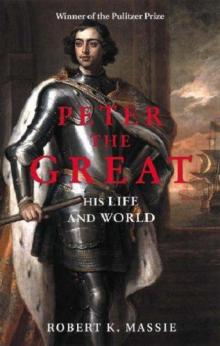 Peter the Great
Peter the Great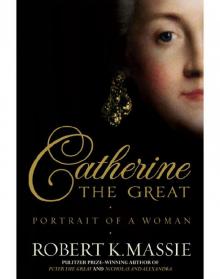 Catherine the Great
Catherine the Great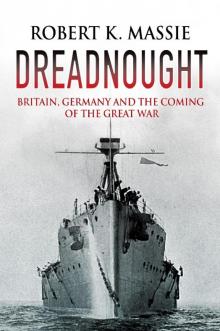 Dreadnought
Dreadnought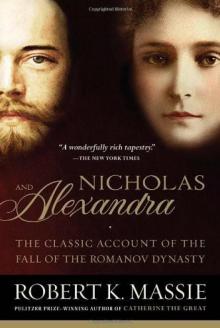 Nicholas and Alexandra: The Classic Account of the Fall of the Romanov Dynasty
Nicholas and Alexandra: The Classic Account of the Fall of the Romanov Dynasty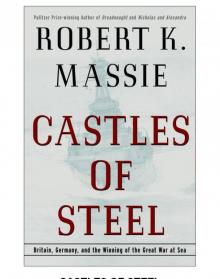 Castles of Steel
Castles of Steel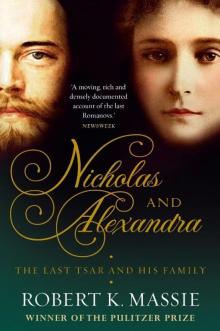 Nicholas and Alexandra: The Tragic, Compelling Story of the Last Tsar and his Family
Nicholas and Alexandra: The Tragic, Compelling Story of the Last Tsar and his Family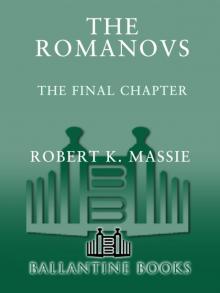 The Romanovs
The Romanovs Dreadnought, Britain, Germany and the Coming of the Great War
Dreadnought, Britain, Germany and the Coming of the Great War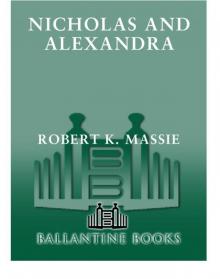 Nicholas and Alexandra
Nicholas and Alexandra